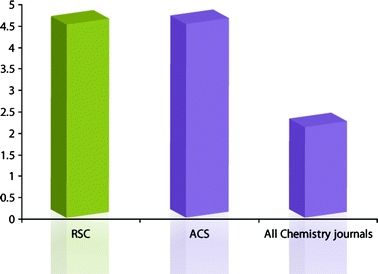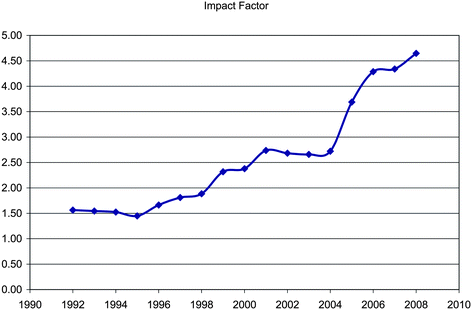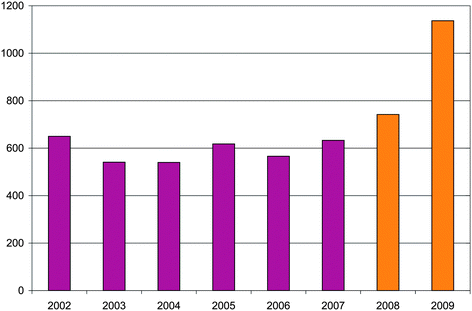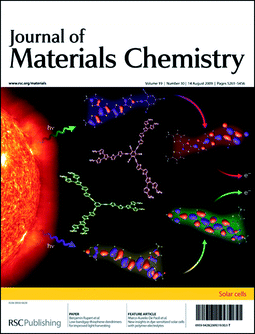20th anniversary starts here!
In 2010, Journal of Materials Chemistry publishes its 20th volume. While in many countries it is 21 or 18 that is the traditional coming-of-age, we feel that 20 is a milestone in the lifetime of this young and dynamic journal; the field of materials chemistry as a whole is not considered to be much older. Throughout our existence, the journal has been lucky to be supported by wonderful Editorial and Advisory Board members (headed by the Chairs of the Board, as detailed in Table 1), who have all given of their time to ensure that the journal is as vibrant and established as you see it today. This year, we will be celebrating their efforts by publishing new Anniversary Articles from some of the top supporters of the journal through the years. As with the usual content of the journal, these will be a mixture of original and review style content, right across the scientific spectrum of the journal. Please join us in our celebrations by accessing the 20th anniversary web page that will go live shortly at www.rsc.org/materials, and by sending us a submission in our 20th year via the web electronic submission system for publication in the journal in the usual way.| Chair | Term |
|---|---|
| Anthony West | 1990–1993 |
| Allan Underhill | 1994–1998 |
| Colin Greaves | 1999–2003 |
| Maurizio Prato | 2003–2006 |
| George Malliaras | 2007–2010 |
In 2009 we had some new additions to the Advisory Board: Clare Grey (SUNY, USA), Jeroen Cornelissen (Twente, The Netherlands), Julian Gale (Curtin, Australia), Mark Green (Kings College, UK), Kuang-Lieh Lu (Academia Sinica, Taiwan). We also said our farewells to Bert Meijer, Ivan Parkin, Ryoji Kanno and Colin Greaves, who have served their terms with the Advisory Board, though they will be sure to continue supporting the journal in other ways. We would like to thank all past and present members of our Editorial and Advisory Boards for their encouragement and advice, as well as welcoming our new Advisory Board members to the fold.
Publication of the 2008 Impact Factors, calculated by ISI, once again brought good news for authors and readers of RSC journals. Nearly all the RSC journals increased in Impact Factor, Immediacy Index and Article Influence, with an impressive average Impact Factor increase of 8.2%. Overall, the average impact factor for the RSC portfolio now stands at 4.7, equal to that of the ACS collection (see Fig. 1). RSC journals feature in the top 10 rankings (by Impact Factor and Immediacy Index) in six of the seven core chemistry categories as listed on ISI, and of the top 100 chemistry journals, ranked by impact factor, 15 are from RSC Publishing. 2009 also saw a 75% increase on the number of articles published in RSC Journals compared to 2007 (…not only are our impact factors leading the way in the chemical sciences, but there are a wider variety of articles available for you to choose from).
 | ||
| Fig. 1 Average 2008 impact factors for RSC and ACS journals. | ||
The Journal of Materials Chemistry Impact Factor has gone from strength to strength with yet another increase of over 7% to 4.65 (see Fig. 2). This record Impact Factor reinforces Journal of Materials Chemistry's position as one of the best journals for publishing urgent new work of the highest quality. In combination with the fast times to publication, which are significantly faster than others in the field, this demonstrates that Journal of Materials Chemistry is the home for exciting new research in the field of materials chemistry.
 | ||
| Fig. 2 Increases in the Journal of Materials Chemistry Impact Factor. | ||
But this growth in Impact Factor does not come with the usual cost of a reduction in articles published—Journal of Materials Chemistry has published more articles in 2008 and 2009 than ever before (see Fig. 3), and our acceptance criteria are as strict as they ever were. We are proud of the fact that more top scientists are choosing to publish their best work with us and we hope that you are all satisfied with the service we provide. Please provide any feedback to mailto:materials@rsc.org
 | ||
| Fig. 3 Growth in Journal of Materials Chemistry. | ||
Some of these many papers were published in the form of contributions to themed issues, of which we have produced more than ever in 2009. At the beginning of the year we had an issue dedicated to inorganic nanowires and nanotubes, guest-edited by Z. L. Wang (Georgia Tech). This was followed by an issue on layered materials (guest-edited by Leonardo Marchese and Heloise Pastore) and one on spintronics and quantum computing, guest-edited by Eugenio Coronado and Art Epstein. We then produced an anniversary issue marking the 75th birthday of one of the journal's great friends and supporters, our long-standing Advisory Board member C. N. R. Rao. Other excellent themed issues included: solar cells (see Fig. 4; guest-edited by Michael Grätzel and René Janssen), inorganic nanoparticles for biosensing, imaging, and therapeutics (guest-edited by Jinwoo Cheon), organic nonlinear optics (guest-edited by Seth Marder), green materials (guest-edited by James Clark and Duncan Macquarrie), and a joint web-theme with Analyst on materials for detection (guest-edited by Charles Martin). It is evident from the range of subjects in our themed issues that Journal of Materials Chemistry covers the full breadth of materials chemistry, and is of great interest for people working in associated disciplines. Coming up we are pleased to announce that we plan issues in other topical and important areas such as tissue engineering (this will be a joint issue with Soft Matter) and also our second emerging investigators issue, building on the success of our first such issue in 2007 which highlighted a selection of up-and-coming scientists who have gone on to great things—some of them even onto the Advisory Board of this journal (Molly Stevens and Jeroen Cornelissen)! So do look out for these issues throughout 2010—there is sure to be something relevant to your area of research.
 | ||
| Fig. 4 Cover of the themed issue on solar cells. | ||
We would like to take this opportunity, on behalf of the Editorial Board, to thank all the readers, authors, and referees who have been involved in shaping the direction and growth of Journal of Materials Chemistry over the last year. We are profoundly grateful to every one of you. We hope that you will join with us in celebrating this wonderful occasion—the 20th anniversary of Journal of Materials Chemistry—and wish for 20 more successful years to come!
Carol Stanier
Editor
George Malliaras
Chair, Editorial Board
News from RSC Publishing
Journals of material importance
Our materials portfolio has expanded significantly over the last year with the addition of two new journal titles.Nanoscale, a new journal encompassing experimental and theoretical work across the breadth of nanoscience and nanotechnology, met with resounding success when it published its first articles in August 2009. Now in its second volume, the journal, which is a collaborative venture between RSC Publishing and the National Center for Nanoscience and Technology (NCNST) in Beijing, China, continues to showcase important and high quality nano-research, providing a forum that is essential reading for all scientific communities working at the nanoscale. www.rsc.org/nanoscale
Polymer Chemistry, a new journal encompassing all aspects of synthetic and biological macromolecules and related emerging areas, will provide a showcase for the ongoing efforts driving polymer chemistry, highlighting the creativity of the field and previously inaccessible applications. The first articles are now freely available online at www.rsc.org/polymers in advance of issue 1, due for publication early in 2010.
Free institutional online access is available for all our newest journals. Access, which is managed by institution and IP address, is provided following a simple registration process. Make sure you and your colleagues don't miss out on the free access by filling in the registration form: www.rsc.org/free_access_registration
Other exciting additions
In response to readers' needs and testament to the innovation of RSC Publishing, we are pleased to announce the launch of new RSC eBook Subject Collections. The 9 new RSC eBook Subject Collections, including a Tutorial Chemistry Texts and Paperbacks package, deliver the high quality content contained in our books into subject specialist packages. With new content being uploaded throughout the year, the new RSC eBook Subject Collections are set to become another key, premier resource. To find out more, please visit www.rsc.org/ebooksThe new flagship journal Chemical Science will launch in mid-2010, and will publish findings of exceptional significance from across all the chemical sciences. Editor-in-Chief Professor David MacMillan of Princeton leads a dynamic international team of Associate Editors responsible for the scientific development of the journal. Free institutional online access to the entire 2010 and 2011 content of Chemical Science will be automatically provided to all existing customers.
Keep in touch with the latest news at www.rsc.org/chemicalscience
RSC is pleased to announce a significant new global symposia series supporting the launch of the Chemical Science. The International Symposia on Advancing the Chemical Sciences (ISACS) meetings will be held on three continents, over three sequential weeks, focusing on distinct subject areas. More information can be found at: www.rsc.org/isacs
Technological developments
RSC Publishing is proud to announce the launch of our powerful new content delivery platform that supports multiple content types. Powered by the industry's leading MarkLogic Server, and benefiting from the interactive browsing functionality offered by RSC's enhanced html mark-up technology, the platform delivers exceptionally fast and precise results. Users can now search 165 years of world-class RSC-hosted content including 20![[thin space (1/6-em)]](https://www.rsc.org/images/entities/char_2009.gif) 000 book chapters, 300
000 book chapters, 300![[thin space (1/6-em)]](https://www.rsc.org/images/entities/char_2009.gif) 000 journal articles and 450
000 journal articles and 450![[thin space (1/6-em)]](https://www.rsc.org/images/entities/char_2009.gif) 000 database records from a single, simple search. Designed around readers' preferences (identified from a detailed and ongoing user-interview process), our user-friendly platform offers faster browsing, intelligent searching, consistent user experience irrespective of content type sought, and simpler more intuitive navigation. We'll be releasing even more exciting functionality later in the year. Please tell us what you think at mailto:rscpublishing@rsc.org
000 database records from a single, simple search. Designed around readers' preferences (identified from a detailed and ongoing user-interview process), our user-friendly platform offers faster browsing, intelligent searching, consistent user experience irrespective of content type sought, and simpler more intuitive navigation. We'll be releasing even more exciting functionality later in the year. Please tell us what you think at mailto:rscpublishing@rsc.orgLast year RSC acquired ChemSpider, the richest single source of structure based chemistry information freely available online, with fast searching of over 21.5 million chemical structures. Alongside the powerful database, the ChemSpider development team brings well over 40 years of additional cheminformatics experience to the RSC, including a chemistry centric document markup system capable of finding chemical names and converting to chemical structures and linking to online resources. Integration of this technology with RSC's existing award winning enhanced html mark-up technology, RSC Prospect, will lead to substantial enhancements in semantic enrichment for the chemical sciences. Find out more at www.chemspider.com
2009 saw the launch of the new RSC journal e-alerts; in 2010 we are hoping to see a continued rise in their popularity. The e-alerts are packed with information and links enabling readers to easily view content as soon as it's published, helping them to stay abreast of journal content. The new e-alert registration system has been designed so readers can manage their own subscriptions, tailoring the information they receive and giving them the freedom to unsubscribe at any point. You can find out more information online: www.rsc.org/alerts
| This journal is © The Royal Society of Chemistry 2010 |


